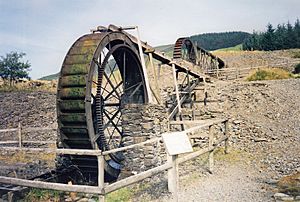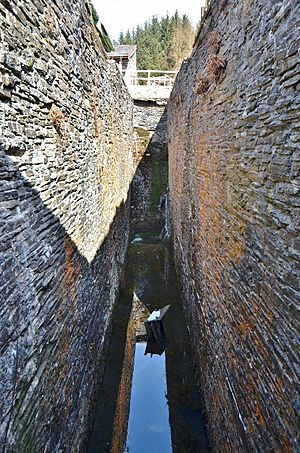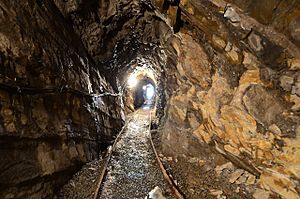Llywernog Mine facts for kids
Quick facts for kids Llywernog Mine |
|
|---|---|

Pair of restored water wheels at Llywernog Mine
|
|
| Type | Silver-lead mine |
| Etymology | "The place of foxes" |
| Location | Llywernog, Ceredigion, Wales |
| First mined | 1742 |
| Restored | 1973 |
| Restored by | Peter Lloyd Harvey |
| Current use | Tourist attraction and industrial heritage museum |
| Website | https://www.silvermountainexperience.co.uk |
| Lua error in Module:Location_map at line 420: attempt to index field 'wikibase' (a nil value). | |
The Llywernog Mine is an old silver and lead mine in Llywernog, Ceredigion, Wales. It started operating in the 1700s. Today, it's a fun industrial heritage museum and tourist attraction called The Silver Mountain Experience.
This mine is special because it's one of the few old silver-lead mines in Wales that still has many of its original buildings and mining machines. A lot of these have been fixed up and are now part of the museum.
Miners first found a special rock called galena here around 1742. This rock contains both silver and lead. Serious mining began in the 1770s. The mine worked on and off for over a hundred years, with different people in charge. But in 1891, the price of lead dropped too low, and the mine had to close. It opened briefly again from 1907 to 1911 to dig for zinc.
In 1974, people started working to restore the mine. It opened as a museum later that year. In 2012, the site was renamed The Silver Mountain Experience. It now includes an exciting underground adventure.
Contents
- Nearby Mines: Llywernog's Neighbors
- History of Llywernog Mine
- Early Days: Digging for Silver and Lead (1742–1825)
- New Companies and Challenges (1840–1852)
- Llywernog United Mining Company (1858–1861)
- John Barton Balcombe's Era (1861–1875)
- Powell Mines Company and Final Closure (1875–1891)
- Zinc Mining and The End of Mining (1907–1914)
- From Mine to Museum: Restoration and The Silver Mountain Experience (1973–Present)
- Mine Features: Shafts and Tunnels
Nearby Mines: Llywernog's Neighbors
Llywernog Mine was not the only one in the area. There were three other mines very close by, all within about a mile. These were Powell's mine, Clara mine, and Ponterwyd mine. Llywernog is the only one of these four that still has buildings you can see today.
Other mines in the wider area included the Bog (also called Craignant Bach) and Bodcoll mine, which was near Devil's Bridge.
History of Llywernog Mine
Early Days: Digging for Silver and Lead (1742–1825)
The first discovery of galena, the rock with silver and lead, happened around 1742. Mining probably started in the 1770s. This was after a new road was built, making it easier to move the ore using ponies. By 1791, about 60 miners worked at Llywernog.
At this time, the mine used at least one large water wheel, called an "engine," to help with the work. Miners were busy digging deeper shafts, pumping out water, and bringing up the ore. By 1795, there were at least two water wheels. However, work sometimes stopped in the summer because there wasn't enough water to power the wheels.
Around 1810, another water wheel was built to help drain the mine. For a while, the mine was even known as "Poole's mine" after its owner at the time. Later, in 1825, some important mining partners from Cornwall tried to lease the mine. But just two years later, they wanted to cancel their lease because lead prices had fallen, making the mine unprofitable.
New Companies and Challenges (1840–1852)
Records show that by 1840, a man named William Lewis was trying to sell the mine. He wanted £500 for it, which included tools, pumps, two water wheels, and twelve tons of ore!
Llywernog Mine then became part of a bigger company called the Rheidol United Mines Company. This company also ran two other mines nearby. However, the owners had disagreements, and the mines changed hands again. By 1845, the new owner, Mr. Shears, had given up on the mines.
Later, in 1851, another person named J. Holdsworth took an interest in the mine. He leased it in 1852, but there are no records of his company selling any ore.
Llywernog United Mining Company (1858–1861)
In 1858, a new group called the Llywernog United Mining Company was formed. They planned to run Llywernog, Ponterwyd, and Bog mines. At Llywernog, they worked on sinking the main shaft even deeper. In early 1859, they managed to drain the mine quite a bit. However, their 20-foot water wheel wasn't strong enough to drain the very bottom of the shaft. Not much mining happened during this time.
John Barton Balcombe's Era (1861–1875)
In 1861, a company run by John Barton Balcombe took over Llywernog Mine. They paid £2,000 for it. To help drain the mine better, they brought in a large 40-foot water wheel from another mine. By December 1862, the mine was drained much deeper, and they planned to go even further.
Mining continued through the 1860s, with about 14 men working there in 1863. In 1868, the Llywernog Mining Company was formed, still managed by Balcombe. By summer 1869, the main shaft was very deep, but a lack of water for the wheel caused the mine to flood again. To fix this, a powerful 16-horsepower steam engine was installed in December. Coal for the engine was expensive, so it was only used when the water wheels couldn't run.
In 1871, they started using ponds to store water. This helped keep the water wheels running even during dry times. This allowed the main shaft to be sunk to its deepest point, about 432 feet (72 fathoms).
However, the amount of lead found and its price were low. A new Llywernog Mining Company was started in 1872, keeping Balcombe but changing the mine captain. They planned to sink the shaft even deeper, but the 40-foot water wheel was already struggling. Work continued until 1873, but the mine started to flood again, and work stopped. A huge 50-foot water wheel was built in 1875, powered by a long water channel (leat) system, about 6 or 7 miles long.
Powell Mines Company and Final Closure (1875–1891)
In 1875, John Barton Balcombe faced legal trouble for misusing money. Work at Llywernog continued for a while as part of Powell's mine. By the late 1870s, the mine was mostly quiet.
In 1882, the Powell Mines Company took over Llywernog. They continued mining, but not much was achieved. In 1891, the low price of lead forced many mines, including Llywernog, to close for good.
Zinc Mining and The End of Mining (1907–1914)
In 1907, a company called Scottish Cardigan Mines, Ltd. leased Llywernog to look for zinc. The big 50-foot water wheel was used to pump out the mine completely. However, by 1911, the price of zinc also fell, and the mine closed again.
There was a brief attempt to mine in 1914, but it wasn't successful. The large 50-foot water wheel, which was a famous landmark, was taken down in 1953 because it was in bad shape.
From Mine to Museum: Restoration and The Silver Mountain Experience (1973–Present)
In 1973, Peter Lloyd Harvey and others formed the Mid Wales Mining Museum Ltd. They got permission to develop the old mine site. Restoration work began in 1974. After fixing up some of the mine buildings, the site opened to the public as a heritage museum in August of that year.
Work continued through the 1970s and 1980s. They restored more buildings and mining equipment and cleared out the underground tunnels.
In 2012, Llywernog Mine was given a new name: The Silver Mountain Experience. This included opening "The Black Chasm," an exciting underground scare attraction set inside the mine itself. Today, it continues to be a popular place for visitors to learn about Wales' mining past.
Mine Features: Shafts and Tunnels
Main Shaft: The Deepest Part
The main shaft of the mine was dug to a depth of about 432 feet (72 fathoms). Miners created many different levels or tunnels branching off the shaft at various depths. A large part of this shaft is now filled with water.
Balcombe's Level: An Accessible Tunnel
Balcombe's Level is a tunnel located to the east of the main shaft. It was the last adit (a horizontal tunnel dug into a mine) that Balcombe opened to search for minerals. This tunnel was the first underground area to be cleared and made safe for visitors to explore.





